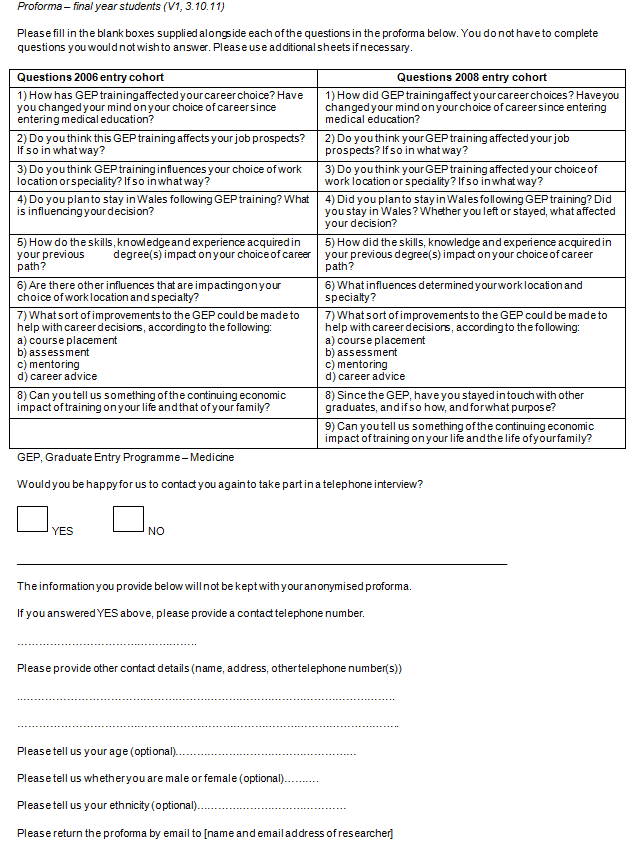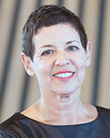full article:
In 2010, the World Health Organization noted that half of the world's population lives in rural and remote areas and only 24% of doctors practise in these regions1. Difficulties in recruiting and retaining healthcare professionals, especially doctors, in such areas seriously compromises the quality of, and access to, healthcare provided to these population groups1,2.
Although information about measures that can have an positive impact on increasing recruitment and retention in these regions is mounting, more research needs to be conducted1,2. Research carried out in different countries and contexts suggests that some undergraduate interventions can assist recruitment and retention in rural and remote areas. For example, there is good evidence that when students from rural areas are trained in schools also located in rural areas, using curricula that are adapted for rural health needs, they are more likely to return to work in those areas1,3, although other factors (such as gender) also play a role. Measures such as early and frequent exposure to rural programs1,4, or locating schools outside major cities, appear to have some impact1. Healthcare education, workforce planning and policy development often take place at a regional or subregional level, therefore understanding 'what works', 'how' and 'why' in specific contexts is helpful. This article reports on a study carried out in Wales that aimed to identify specific curriculum, personal and professional factors influencing students' and early career doctors' career destinations.
Wales has a population of slightly over 3 million5 dispersed over an area of almost 21 000 km2. Although it is not as geographically vast as, for example, remote regions of Canada or Australia, the variability in population density, extent of rurality and the difficult terrain make it susceptible to the same problems in recruitment and retention of healthcare professionals5. Cardiff, the capital city of Wales, has 2482.5 inhabitants per square kilometre, whereas Powys - the largest local authority in Wales and a primarily rural county of more than 5000 km2, accounting for a large part of the mid-west of the country - has 25.7 inhabitants per square kilometre5.
Vacancies are a particular problem in some medical grades, specialties and geographic locations. This is particularly the case in more rural settings such as the west, north and mid-Wales6. A 2012 review identified that the current growth in general practice in Wales was insufficient to meet predicted need with other specialties at high risk, including emergency medicine, paediatrics, general medicine, obstetrics and gynaecology, and psychiatry6.
The medical program at Swansea University's College of Medicine is relatively new. The 4-year Graduate Entry Programme (GEP) in Medicine was launched in 2004, in collaboration with Cardiff University. This enabled students to study at Swansea for the first 2 years before transferring to Cardiff for the final 2 years. On graduation, in common with all doctors in the UK, newly qualified doctors undertake a 2-year foundation (internship) program comprising the F1 year (after which doctors are fully registered by the General Medical Council) and the F2 year (which primarily prepares doctors for specialty training). This is usually followed by postgraduate training, the nature and length of which varies according to specialty. GEP has a strong local ethos, with a focus on providing early exposure to clinical practice across a range of healthcare settings, including varied exposure to rural environments in west, north and mid-Wales. An aim of this approach is to contribute to an increase in retention of medical graduates in the more rural areas of the country, regarded as 'our hinterland'.
The present study aimed to gain further understanding about GEP students' decision-making processes surrounding educational and training pathways, from initial choice of location to study medicine, to subsequent decisions around location and specialty for postgraduate training posts. Central to the study was also the desire to understand the views of these graduates regarding practising as a doctor in Wales, and how their perceptions and future career options were affected by contact with practitioners in rural environments.
The study aimed to investigate the following questions: 'How and why do students elect to study in Wales and GEP?', 'How do students view their time on the GEP programme?' and 'What influences students' choices about either staying in, or leaving Wales, post-graduation?'.
The study was carried out between February 2012 and February 2013, focusing on the GEP students who graduated in 2010 and 2012. The former cohort was chosen because at the time of the study they were completing their second year of foundation training (F2) and were about to embark on their specialty training. The latter cohort was chosen because they had submitted their applications to start their first year of postgraduate training (commencing in August 2012). These were the decision points of most interest to this study. Table 1 presents the demographic characteristics of the sample for both phases.
A mixed-method, sequential, exploratory study7 was conducted by means of an online questionnaire followed by semi-structured telephone interviews (Fig1 and Appendix I). The questionnaire consisted of eight or nine open-ended questions (the 2006 cohort had an additional question regarding whether they were still in contact with colleagues from the course), followed by four demographic questions. The replies were analysed by the research team to gain an initial understanding of issues relevant to a larger sample of graduates, and define the interview schedule that would explore these further. This type of mixed methods design was particularly appropriate for this study as it allowed the research team to build an overall picture of the issues and then follow up issues with both cohorts in more depth8,9.
Recruitment for the questionnaire was carried out through individual emails (either university or, because of data protection legislation, via a third party) to all identified students and doctors in training. Invitations to participate were also posted on Facebook and sent via Twitter, with a free entry into a prize draw as an incentive to participate. Respondents to the online survey who indicated they were happy to be contacted for the phase 2 telephone interviews were then contacted by telephone and email. Interviews were audio-recorded and professionally transcribed.
All data were anonymised, and databases linking personal data with unique identifiers were stored on a separate, password-protected computer drive. Thematic analysis of the data was conducted and managed by QSR Nvivo v10 software (QSR International; http://www.qsrinternational.com/default.aspx). The anonymised data were analysed inductively following the method advocated by Miles and Huberman10. Three streams of activity - data reduction, data display and the drawing of conclusions - form an interactive, cyclical process. Following an initial phase of open-coding by the study researchers (SE and ADS), identified themes were discussed and refined by the wider research team through multiple group analysis meetings. As a consequence, thematic hierarchies were identified.
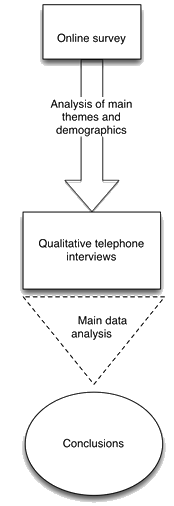
Figure 1: Overview of the study methodology.
Ethics approval
Ethics approval was granted by Swansea University and by Cardiff University.
The results are presented in two parts: responses to the survey and analysis of interview transcripts, with verbatim quotes illustrative of identified themes.
Phase 1 - online survey by questionnaire
The online questionnaire aimed to gauge the views of a larger sample of respondents regarding studying and working in Wales, and to identify key aspects to be explored in detail by follow-up interviews. The final valid response across both cohorts for the questionnaire was 30% (n=42/138). Refer to Table 1 for this and the demographic characteristics of the respondents.
Three main themes were identified as being important for, and having impact on, respondents' career decision-making: early clinical exposure, personal relationships and financial considerations (Table 2). At different stages of their careers, respondents from both cohorts seemed to share views across each of the themes. Phase 1 highlighted that career and training decisions are highly dependent on a complex multifactorial relationship between different factors relating to individual circumstances and 'life stage', availability of jobs/training posts and location. Such relationships were further explored in the subsequent interviews (phase 2).
Table 1: Sample characteristics and demographic data
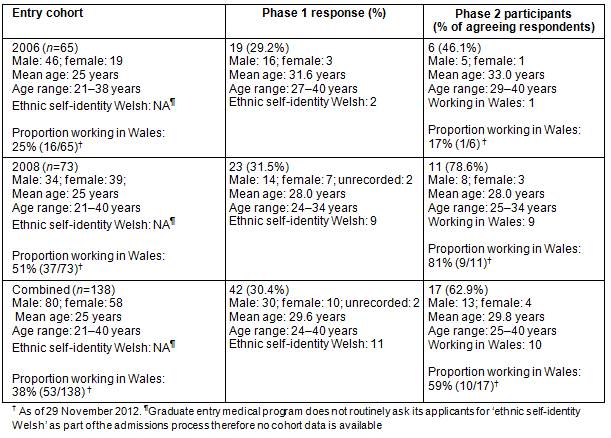
Table 2: Summary of themes of phase 1
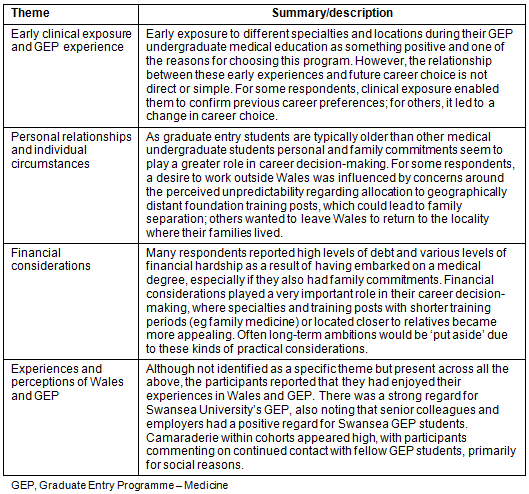
Phase 2 - follow-up interviews
The phase 2 follow-up interviews began 6 months after the phase 1 survey closed. Twenty-seven participants indicated willingness to participate in interviews, but recruitment proved difficult (see discussion), particularly for doctors in training, and ultimately semi-structured interviews were carried out with 17 participants (6 from cohort 1 and 11 from cohort 2). When interviewed, all the participants were in postgraduate training positions. The 2008 cohort participants had started their foundation training and were largely in Wales (9/11), and the 2006 cohort participants had taken up specialty training positions but mainly outside Wales (1/6; Table 3). Even so, no noticeable differences were found between these two cohorts' views.
Analysis of the interview data identified four main themes: studying at Swansea, education highlights, preparedness for practice, and recruitment and retention. Together these themes provide clarification of the underlying factors associated with the study's research questions.
Table 3: Interview schedule (phase 2)
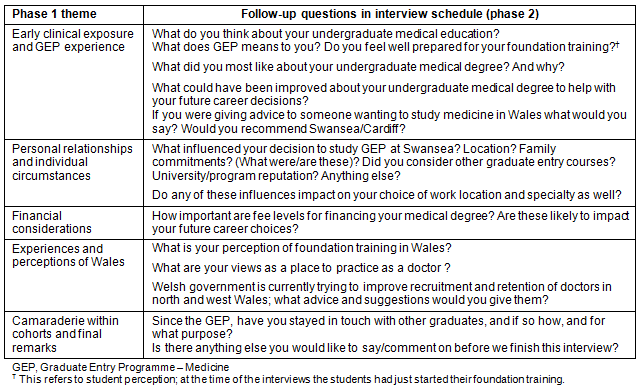
How and why did students elect to study in Wales and Swansea?
Studying at Swansea: Participants recorded first and foremost being motivated by their passion for medicine. Therefore being offered a place was an important driver for their decision to study at Swansea. Other reasons related to personal relationships, location and the potential lifestyle that the location offered to them and their families. The friendliness and ambience of the college and the course structure were also influential in participants' choice of the Swansea medical program. Although there was a great deal of individual variability in the data, some polarisation between participants' views was noted, with two groups emerging: those wishing to return to Wales and those from elsewhere wanting to discover Wales.
I'm a local boy, I wanted to come home so ... (2008 cohort student)
... after the interview, or before, I can't remember, I just, I walked out to the campus and then realised you could see the beach and stuff [laughs].
[Interviewer: And you were sold, were you?]
Yes, yeah, I just thought it would be a nice place to spend some time. And I kind of thought that I would get a medical degree either place and that just seemed like a nice thing to happen at that time. (2006 cohort student)
How did students view their time on the GEP?
Education highlights and preparedness for practice: These two themes revealed that medical education at Swansea was regarded positively when participants reflected back on their actual educational experience. There was a clear appreciation of the various teaching methods used: combination of lectures, Learning Opportunities in the Clinical Setting (LOCS) and Integrated Clinical Method (ICM), as well the early clinical exposure. The exposure to various locations, both rural and urban, was also appreciated as a very positive and unique aspect of this course.
... in terms of seeing different places and how different hospitals do things and you get different experiences. (2008 cohort student)
Such aspects were seen as important to make students feel better prepared for their foundation positions. However, some variability linked to individual experience and/or individual inclination was noted.
... looking back now, my preparation for foundation training wasn't as good as perhaps it could have been because I don't think we were encouraged to be part of the team ... (2006 cohort student)
... I was one of those that did quite a lot on the wards when I was a student so when it came to being a doctor and doing it for real, it didn't feel like too much of a change, you know. (2008 cohort student)
... I felt I think as well prepared as most people. (2008 cohort student)
What influences students' choices to stay in or leave Wales, post-graduation?
Recruitment and retention: This theme focused on the reasons participants wanted to stay in Wales and students' suggestions for improving recruitment. Rural working was viewed very positively as an opportunity to develop specialist skills and independence without the benefit of specialist services on the doorstep.
... the more remote you are the more medicine you have to practise and I think you know, that's an angle to sell ... (2008 cohort student)
Accordingly, many graduates see 'rurality' as a beneficial opportunity to develop new skills. Nonetheless, the issue of isolation and lack of opportunities outside of the professional domain was mentioned by several participants.
... it can be quite isolating as well ... if you're not from there, you'll tend to make friends who are related to the medical side of things, and there's not so much going on in the city as perhaps in bigger cities, so it's kind of hard to get away from it. ... But medically, I'd say it's -it's good in that, I thought it was ... quite captivating. (2006 cohort student)
They also highlighted the need to market and promote Wales and rural working effectively, so that Wales and rural medicine are regarded not as a dead-end career choice but as a new opportunity:
... should really sell the place more on ... the amount of research that's done in Wales and ... the amount of opportunities for learning and ... [sighs] ... trying to show that it's a contemporary, ... quite modern place with ideas and opportunities, not ... a sleepy little place where nothing really happens. (2008 cohort student)
The respondents also point out the value of incentives for retention across all career stages and grades.
I think to attract non-Welsh people to there, you probably need to offer more money and it comes down to that ... (2008 cohort student)
Participants from the 2008 cohort were more likely to refer to the incentivising nature of the free accommodation, perhaps reflecting wider economic conditions in the UK or because they themselves were benefiting from it. This could explain why 9 out of the 11 2008 interviewees from the 2008 cohort chose to do their F1 year in Wales.
... foundation training is better in Wales because ... they still have the first year's accommodation on-site for free at most hospitals ... but it does save a large chunk of money which you can then use to either start paying off the loans ... (2008 cohort student).
Discussion
Crucial to the planning of effective interventions to enable appropriate recruitment to rural areas is an understanding of 'what works' and 'why' in a specific context - in this case, Wales. This study was designed on that basis. Respondents' answers revealed a complex, multifactorial relationship of opinions with high individual variability. A number of clear themes emerged which will inform Swansea GEP regarding some factors influencing students' decisions to study in Wales (specifically Swansea in this article), their learning experience in this context and, more importantly, their choices about either staying in, or leaving, Wales after graduation.
The major strength of this research lies in its ability to capture the views of Swansea University's medical graduates about their education and career choices early in their medical training and careers, thus limiting the risk of recall bias. This study was the first of its kind to achieve external funding to track Swansea's medical graduates and how the process of keeping in contact with graduated students can be improved. The study informs a wider understanding of both generic and specific factors affecting career choice, particularly in rural areas.
The principal limitation of the study was its relatively small scale, with a low participation level in the phase 2 interviews. Recruitment to phase 1 achieved only an overall 30% response, despite three reminders and an incentive scheme, which is consistent with other electronic online surveys that recruit via email11,12. The study identified some of the difficulties that medical schools have when researching their graduates without more formal, regulatory or professional body support or a mandate such as that of the Australian and New Zealand Medical Schools Outcomes Database (MSOD)13. It may be that, as doctors move further away from their medical school and medical education, participation in educational research becomes a low priority in the context of 'busy lives'. Obtaining permission from students before they graduate to maintain contact via private email addresses (rather than mobile telephone numbers, which may change) may improve future research efforts as it may enable access to national databases of graduate destinations (such as those held by postgraduate medical and dental deaneries or the UK General Medical Council).
Despite the limitations described, these findings indicate that many GEP students enjoyed studying and working in Wales. Early exposure to practice and a variety of work locations were aspects contributing towards the enjoyment of the program and the good level of preparation for future practice. Nonetheless, local recruitment evidence shows that these graduates still migrate away and many rural positions in Wales remain vacant. A good learning experience is important but not enough to retain this new workforce in this region. Such results are supported by a recent study in Australia suggesting that early immersion in rural and remote areas may have a greater effect on those who have already decided to work rurally14.
The impact of high vacancy levels will soon become more pressing: currently, 20% of the medical and dental workforce in Wales are aged over 50 years, of whom only 25% are female6. If career grade posts are not filled, services will discontinue when the ageing workforce enters retirement and rural populations may be further disadvantaged.
Entrants into graduate entry medical education programs are typically older than most entrants into 'standard' medicine programs, and thus frequently have personal and family commitments that may constrain career choices. The present study's findings resonate with those of Lee et al15 who evaluated the 4-year graduate entry program offered by the Australian National University. They found that family, partner and work commitments were disincentives for rural placements, even in the presence of incentives such as assistance with relocation. The present study's findings show a similar pattern, with respondents modifying location choices to minimise impact on family life. In Wales, incentives to retain graduates for foundation positions include free accommodation and family-friendly policies, which include less than full-time training posts.
Isolation is a potential barrier to rural work16,17, a finding that was borne out in the present study. Greenwood and Cheers found that loneliness has a particular impact on women18. With the increasing feminisation of the UK medical workforce, further consideration of the particular needs of women is increasingly important for planning future workforce provision. As medical graduate demography changes, efforts to address rural recruitment and retention issues must include measures to support women.
If workforce planning in Wales and other rural and remote areas is to meet the healthcare needs of the local populations, emphasis must be given to developing a multi-skilled and supportive workforce with generalist professional skills. Strasser and Neusy19 have indicated that there is a mistaken assumption that generalist activities in rural and remote areas are of less importance than those undertaken by specialists in urban areas. This assumption, combined with educational and infrastructure resource constraints, limited availability of library support and unreliable broadband internet access, might suggest that rural medical programs are also of a lower quality, despite clear evaluation data indicating equivalence15,20. The significance of this rhetoric should not be underestimated and particular efforts will be needed to address the structural shortcomings that limit the ability of those living and working in rural areas to participate fully in lives that are technologically equivalent to those of their metropolitan colleagues. Furthermore, as healthcare workers often have families to consider, the authors concur with Lehmann et al21 that planners will also need to take account of occupational opportunities for partners and educational opportunities for children.
Workforce recruitment and retention for rural healthcare is an international issue. Evidence from THEnet (Training for Health Equity Network) demonstrates that training rural health workers in the rural setting greatly improves recruitment and retention in rural and underserved areas22. To some extent this was echoed by participants in this study who emphasised how rural work can offer a contemporary lifestyle and unique opportunities for professional learning and skill development. It is clear that sustained efforts to present a counter-narrative to the present debate about the negative aspects of rural medicine are essential if key healthcare services are to be maintained. As has been emphasised by Frenk et al., 'connections between [health professional] education and health systems' are vital if these systems are to be strengthened in an 'interdependent world''23 Promoting the benefits of rural life, from both work and leisure perspectives, as well as the promotion, in the early years of medical education, of a wide range of possible working environments and positive rural health educational experiences, may go some way to assist with this endeavour.
Despite the fact that participants in this study emphasised many positive aspects of studying in Wales, placement as students and the prospect of entering postgraduate training in the more rural parts of Wales are, for some, inhibited by feelings of isolation and separation from peers and families. Some students do not want rural placements and see these as a backward step in the natural progression of their work and career. Graduates are concerned about discontinuity with family ties (eg due to perceived unpredictability of job allocation or the inability of partners to find work) and tend to gravitate to where families reside.
As many studies have evidenced, experience of rural health at an early stage in a student's career pathway, aimed at informing students about both rural and urban health contexts, ways of working in rural environments and benefits of rural work and rural lifestyle, help to prepare students for rural health care and may help to overcome issues and break down barriers in behaviour and opinion. Efforts to overcome the demographic divide are essential if the Welsh community, like other rural communities, is to be appropriately provided for. Such challenges will continue to exist in line with changes in contemporary lifestyles. Gaining and sharing a deeper understanding of issues, strategies and solutions, both those generalisable across countries and contexts, as well as those specific to certain contexts, is essential.
Acknowledgements
The authors wish to acknowledge St David's Medical Foundation, which funded this research project, and the essential contributions of the other members of the research team for phase 1 of this project: Drs Lynn Monrouxe and Melanie Jones, and Professor Aidan Byrne; also, the valuable administrative work of Ms Vicky Davies and, of course, the cooperation of the study participants throughout.
References
1. World Health Organization. Increasing access to health workers in remote and rural areas through improved retention: global policy recommendations. Geneva,Switzeland: WHO, 2010.
2. Department of Health and Ageing. Rural clinical training and support 2011-2014 - program guidelines. Canberra, ACT: DoHA, 2012.
3. Grobler L, Marais BJ, Mabunda SA, Marindi PN, Reuter H, Volmink J. Interventions for increasing the proportion of healthcare professionals practising in rural and other underserved areas. Cochrane Database of Systematic Reviews 2009, issue 1. art. no.:CD005314.
4. Jamar E, Newbury J, Mills D. Early career location of University of Adelaide rural cohort medical students. Rural and Remote Health 14: 2592. (Online) 2014. Available:www.rrh.org.au (Accessed 12 May 2014).
5. Office for National Statistics. Population estimates for England and Wales, mid 2011 (census based). Office for National Statistics. (Online) 2012. Available: http://www.ons.gov.uk/ons/datasets-and-tables/index.html (Accessed 13 February 2014).
6. Ponton M, Longley M, Norton K. The best configuration of hospital services for Wales: a review of the evidence. The workforce. Pontypridd: Welsh Institute for Health and Social Care, University of Glamorgan, 2012.
7. Tashakkori A, Teddlie C, Eds. Handbook of mixed methods in social and behavioural research. Thousand Oaks: Sage Publications, 2003.
8. Creswell JW, Plano Clark VL, Gutmann ML, Hanson WE. Advanced mixed methods research designs. In A Tashakkori, C Teddlie, Eds. Handbook of mixed methods in social and behavioural research. Thousand Oaks: Sage Publications, 2003; 209-240.
9. Driscoll DL, Appiah-Yeboah A, Salib P, Rupert DJ. Merging qualitative and quantitative data in mixed methods research: how to and why not. Ecological and Environmental Anthropology 2007; 3(1): 18-28.
10. Miles MB, Huberman AM. Qualitative data analysis. 2nd ed. London: Sage Publications, 1994.
11. Kittleson MJ. Determining effective follow-up of email surveys. American Journal of Health Behaviour 1997; 21: 193-196.
12. Cook C, Heath F, Thompson RL. A meta-analysis of response rates in web-or internet-based surveys. Educational and Psychological Measurement 2000; 60(6): 821-836.
13. Medical Deans Australia and New Zealand. The MSOD [Medical Schools Outcomes Database] Project - a tool for medical workforce planning and education evaluation. (Online). Available: http://www.medicaldeans.org.au/msod (Accessed 19 June 2014).
14. Playford DE, Nicholson A, Riley GJ, Puddey IB. Longitudinal rural clerkships: increased likelihood of more remote rural medical practice following graduation. BMC Medical Education. 2015; 15(1): 1-9.
15. Lee Y, Barnard A, Owen C. Initial evaluation of rural programs at the Australian National University: understanding the effects of rural programs on intentions for rural and remote medical practice. Rural and Remote Health 11: 1602. (Online) 2011. Available: www.rrh.org.au (Accessed 7 November 2013).
16. Charles D, Ward A, Lopez D. Experiences of female general practice registrars: are rural attachments encouraging them to stay? Australian Journal of Rural Health 2005; 13(6): 331-336.
17. Henry J, Edwards B, Crotty B. Why do medical graduates choose rural careers? Rural and Remote Health 9: 1083. (Online) 2009. Available: www.rrh.org.au (Accessed 23 May 2013).
18. Greenwood G, Cheers B. Women, isolation and bush babies. Rural and Remote Health 2: 99. (Online) 2002. Available: www.rrh.org.au (Accessed 12 December 2013).
19. Strasser R, Neusy A-J. Context counts: training health workers in and for rural and remote areas. Bulletin of the World Health Organization 2010; 88: 777-782.
20. MacDowell M, Glasser M, Fitts M, Nielsen K, Hunsaker M. A national view of rural health workforce issues in the USA. Rural and Remote Health 10: 1531. (Online) 2010. Available: www.rrh.org.au (Accessed 6 November 2013).
21. Lehmann U, Dieleman M, Martineau T. Staffing remote rural areas in middle- and low-income countries: a literature review of attraction and retention. BMC Health Services Research 2008, 8: 19.
22. Pálsdóttir B, Neusy A-J. Transforming medical education: lessons learned from THEnet. Commission paper. Belgium: Training for Health Equity Network, 2010.
23. Frenk J, Chen L, qar A Bhutta Z, Cohen J, Crisp N, Evans T, et al. Health professionals for a new century: transforming education to strengthen health systems in an interdependent world. Lancet 2010; 376: 1923-1958.
___________________________________
Appendix I: Tracking Our Graduates project (online questionnaire)
